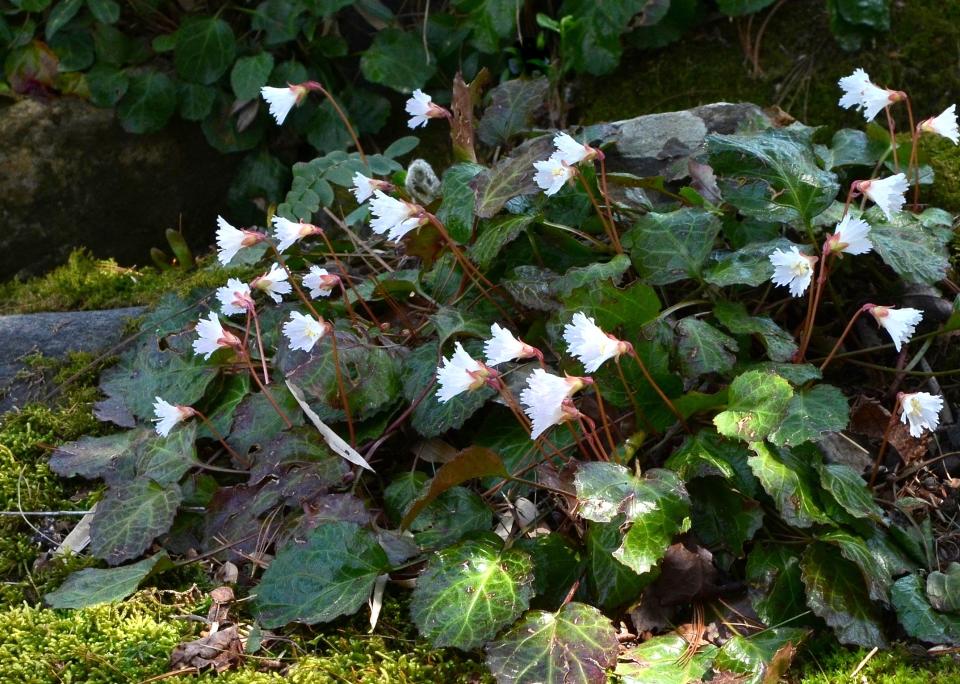Spring Emphemerals offer a short but breathtaking show
Taking a walk in the woods in early spring is an exciting time to venture out. There are wonderful wildflowers that decorate the forest floor and give a touch of beauty to the brown leaves as they emerge from dormancy. Some of these delights can be lumped together in a group called Spring Ephemerals. Emphemeral refers to perennial plants that emerge quickly in the spring and then die back, to rest until the following spring.
Spring Emphemerals make an appearance as soon as the weather hints at warmth and disappear as it gets warmer. During their brief period of glory, they shine like a morning star and then set seed and return to the ground below. Today, I was walking in my woodland garden and was pleasantly surprised to see a lovely patch of bright, white, daisy-looking flowers that were just starting to bloom.
These charming flowers are Bloodroot, (Sanguinaria) and they pop up before the foliage, making them stand out even more. As the flowers mature, the leaves come along and I fine the shape of the leaves to be quite attractive and interesting. The leaves grow larger as the summer progresses, sporting deeply cut lobes that are distinct and eye catching. This is a North American woodland perennial that is called bloodroot because it has a red sap that oozes from the roots when cut. Native American basket makers used the sap as a source of red dye. However, they did not use it as face paint because it is toxic if rubbed onto the skin.

Today, I also came across the leaves of Virginia Bluebells, (Mertensia virgninica), starting to break through the ground. This is a cherished native that delights us in spring with nodding clusters of pink buds that open to a sky-blue flower. These charming belle shaped flowers have cool, soft green foliage making a beautiful display in a shaded area of the garden. You need to enjoy them quickly because as the flowers fade, so does the foliage and before you know it, they disappear and go dormant until the following spring.
In recent years, Brunnera has become a favorite of mine for the shade garden. This trouble-free plant has dainty blue flowers that resemble forget-me-nots. The flowers stand high above the foliage on thin stems that sway in a gentle breeze. I grow several different ones but the one I like best is Brunnera ‘Jack Frost’. This delightful early bloomer was chosen the perennial of the year in 2012 by the Perennial Plant Association. This hardy plant is grown not only for the flowers but also for the veined heart-shaped leaves that are green and white and if it does not get too hot and dry, they look pretty all summer long. My husband used to think that these were caladiums leaves, a plant he always wanted me to grow. I did not tell him that those variegated showy leaves were not caladium.
One plant that is quite unique is Oconee Belle (Shortia Galacifolia) which I fine blooming from mid-March to early April. This is unique because it is a rare flower of the southern Appalachians, found only in a few locations in the mountains of North and South Carolina. Although the flower has a very limited range in the wild, it grows well in gardens and is commercially available.
Phlox divaricate, a perennial with delightful blue or white flowers, is another woodland native which forms a mat of foliage with stems that typically reaching 10 to 12 inches tall. My friend Pat Burton introduced me to this plant and told me to be sure and purchases the variety called ‘Blue Moon’. It is a lovely native phlox groundcover featuring clouds of rich blue blooms that float above green foliage. It has a slight fragrance to wake up one’s senses, and it flowers in March and April where I live. It is a perfect addition to a rock garden or any shady spot where it can slowly naturalize. I have it by a stream and I am hoping that one day, the mats will become large enough that they drape over the rocks lining the stream.
Trilliums (Trillium) are perhaps the most valued and sought-after native ephemerals, emerging in March and lingering until the end of April. The flowers have 3 petals and 3 bracts of various colors. There are many different trilliums with two major groups, those with the flowers held above the bracts on a stem and those without stems or sessile. The flowers can be small in size or large and showy. I love to drive up the old Saluda Grade and turn onto Pearson’s Fall Road because the woods on either side of the road have trilliums growing wild throughout the woods. It is a sight to see.
These plants take a little morning sun and prefer afternoon shade or all-day dappled shade. Leaves are the best mulch for growing these woodland species so do not think you have to buy mulch in the store. Woodland ephemerals love a slightly acidic soil and the rich houmous soil as created by an accumulation of leaf litter in the forest. I have some of all these growing in my garden but to see them in the wild is even more exciting.
TO MY READERS: You are welcome to come visit my garden Saturday, April 13. You can email me for more information. BMontgomery40@gmail.com
Betty Montgomery is a master gardener and author of “Hydrangeas: How To Grow, Cultivate & Enjoy,” and “A Four-Season Southern Garden.” She can be reached at bmontgomery40@gmail.com.

This article originally appeared on The Fayetteville Observer: Spring Emphemerals shine like a morning star

